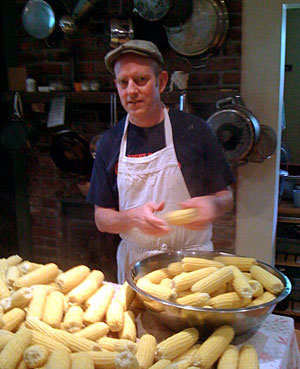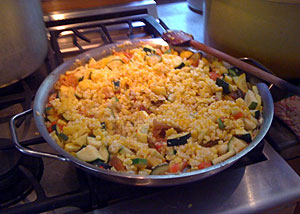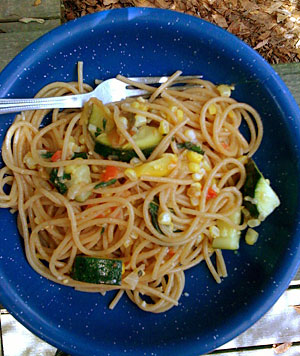Many people claim they don’t have time to cook fresh meals “from scratch.” In Tom’s Kitchen, Grist’s food editor discusses some of the quick and easy things he gets up to in … well, his kitchen. Forgive the lame iPhone photography.
 What a corny guy! (Alice Brooke Wilson)OK, I promise this will be the last time I tweak a corn-industry communications flack for declaring me an “anti-corn elitist.” (I responded to the factual aspects of the critique here.)
What a corny guy! (Alice Brooke Wilson)OK, I promise this will be the last time I tweak a corn-industry communications flack for declaring me an “anti-corn elitist.” (I responded to the factual aspects of the critique here.)
As I wrote Wednesday, I’m actually quite pro-corn — as long as we’re talking about corn grown at appropriate scale for people to eat, and not the stuff pumped out in vast monocrops for meat and car-fuel factories. This very week, the sweet-corn patch on the farm I help run, Maverick Farms, came ripe. As the farm’s founder (and mentor) Bill Wilson has been doing for 30 years now, we invited some friends over to help harvest it and put up a bunch of it for winter in the freezer.
It’s a grueling task: you pick it, peel it (breaking off the bad spot at the tip, typically occupied by a worm, the scourge of organic corn), quickly boil it, cut it off the cob, bag it, and, finally, freeze it. The process took half a dozen people nearly all day. I was called in to whip up a quick and satisfying lunch — one featuring produce coming off the farm.
For the pasta I came up with, you don’t need to live on a farm, though it probably helps to have access to a farmers market. While corn stores fairly well in the fridge, the sugars begin to break down as soon as its harvested, so fresh-picked is the most flavorful.
Pro-corn summer pasta lunch
(Feeds five)
- Extra-virgin olive oil
- Aromatic vegetables, such as 2-3 fresh (uncured) onions and and 1 to 2 cloves garlic, and — if you want a little spiciness — 1-2 small chile peppers, chopped.
- Lots of summer veggies, chopped coarsely. I used 2 zucchinis, a crook-necked yellow squash., a large and beautiful German Johnson tomato, and a couple of plum tomatoes.
- Corn! I used a couple of big spoonfuls of corn cut fresh off the cob. I recommend at least two cobs’ worth of freshly cut corn.
- Some herbs, cleaned. I used two big handfuls of basil, and another one of parsley.
- Hard cheese, grated, probably a half cup, plus more to grate over pasta at the table. I used the last of a precious chunk of Parmigiano-Reggiano.
- A pound of spaghetti; I always use whole wheat these days.
- Kosher salt for the pasta; sea salt and a loaded pepper grinder for seasoning the veggies.
 Put eight cups of water and 2 teaspoons of salt in a medium-sized pot. Brace yourself — you’re going to be using the great food-science writer Harold McGee’s radical, highly effective low-water method for cooking pasta.
Put eight cups of water and 2 teaspoons of salt in a medium-sized pot. Brace yourself — you’re going to be using the great food-science writer Harold McGee’s radical, highly effective low-water method for cooking pasta.
Now get the veggies started. Put your largest skillet on the stovetop over medium heat. Give it a good splash of oil — enough to cover the bottom, with a little left to spare — and heat until it shimmers. Add the aromatic veggies, and cook, stirring, until they’re soft and fragrant. If you’re using uncured (fresh) onions and garlic, it will only take a couple of minutes.
Now add the more substantial of your summer veggies — in my case, the zucchini/squash combo. Turn the heat down a bit, and let them cook, stirring often.
Now turn heat to high under the pot of water; and add the pasta. As McGee puts it, “cook uncovered, stirring frequently to keep pasta submerged, until pasta is almost al dente, 8 to 10 minutes, depending on pasta.” So now you’ll be fussing over the pasta and the veggies at once. When the squash mix begins to soften, add the next most substantial of the veggies, in my case the tomatoes. Stir them in with a vigorous lashing of salt. This will help draw out their juices, which will begin to form a delicious sauce.
 Summer pastaAfter a few minutes, with the squash mix softening but still retaining a bit of bite and the tomatoes breaking down, stir in the corn. It will sort of poach in the veggie juices. At this point, the pasta is about ready.
Summer pastaAfter a few minutes, with the squash mix softening but still retaining a bit of bite and the tomatoes breaking down, stir in the corn. It will sort of poach in the veggie juices. At this point, the pasta is about ready.
McGee correctly notes that the leftover water from this pasta method is a valuable resource. He writes:
It’s thick, but you can still easily ladle it out by tilting the pan. And it’s very pleasant tasting: not too salty, lots of body, and lots of semolina flavor. Whole-wheat pasta water is surprisingly delicious.
So, just before draining the pasta into a colander, grab a soup ladle’s worth of it and dump it into the veggie mix. Now drain the pasta, and place it in a large bowl. Dump the cooked veggies over the pasta. Add the chopped herbs and grated cheese, along with a vigorous grind of black pepper. If you’re like me, you won’t be able to resist give it good additional lashing or three of olive oil. Toss, and taste for seasoning. Add salt and pepper if needed.
Serve immediately, and pass a chunk of hard cheese and a grater around the table.



